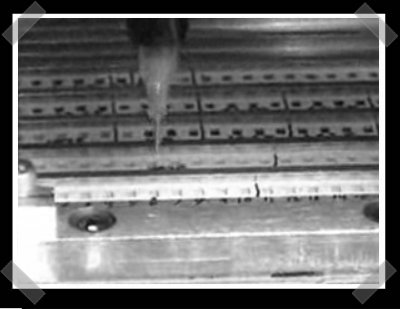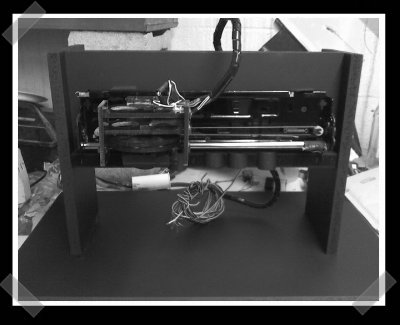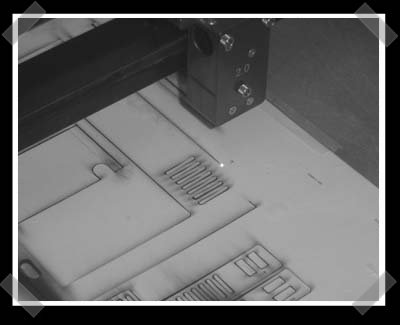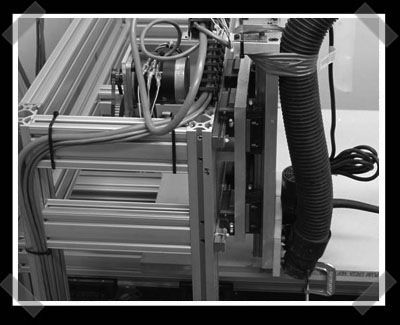
Just when I thought I’d seen most of the CNC mods out there, [Steve Ciciora] (who happens to be one of the driving forces behind the killacycle) sent in his diy solder paste dispenser *and* his diy pick and place machine. Both are extensions of his CNC taig mill. Hopefully [steve] will put up some more details of his mill mods.
cnc hacks937 Articles
Automatic Color Detection

[KLOZ] submitted his final project from college. Rather than an expensive CCD camera, he used a set of colored resistors LEDs and a light dependent resistor (I’m assuming he means a photo resistor) to determine the color of a product (m&ms). He used the carriage from an old HP inkjet, a custom cnc cut wheel to separate and deliver the m&ms and a Parallax propeller micro controller board to tie it all together. Now he can hog all the green ones for himself.
Update: Yes, I’m an idiot. I did mean colored LEDs. People who caught me will get an email – I’ve got something for ya.
Check out the sorting demo video after the break
Everybody Needs One

Not the hack o’ the day, but you guys might have noticed that I’ve been pretty quiet on the engadget How-To front. I’ve been spending all my spare time in my garage working on a CNC conversion for the mini mill I bought a few months ago. It features pic based microstepping controllers that handle up to 54 volts and 3amps. I settled for a modified PC power supply for now. I’ve got plans for this thing, including some stuff just for Hack-A-Day. All the mechanical and electronic work is completed; now I’m taking a breather while I wait for the actual beefy stepper motor for the Z-axis pictured above. I celebrated with a coffee stout.
Printer Hacking Roundup

Today’s roundup is in honor of all those inkjets, laser printers and plotters that have been cracked open and modded to perform unspeakable tasks. This is a bit of an experiment, so let me know what you think.
First, there’s the classic DIY CD printer. Aside from dremeling the back of the printer, making the cd cartridge from a decent material is probably the most difficult task. I used to print on my DVDs, but now I just rip ’em to my media server.
Not really a hack, but someone discovered that they can get ever nicer photo transfers if they use an inkjet instead of a laser printer to create the transparencies.
Not to be forgotten, using the fuser from a laser printer to transfer laser printed artwork onto PC boards.
If you missed it, [Volkan] and [Stefan] gutted an Epson C84 to make a direct to PCB etch resist printer. The feed the board in and get a printed design, ready for the etch tank. (once it’s dry, of course) Someone else is working on the same hack with a C87.
If you’re evil, there’s the classic paper shredding printer.
You could use an old network printer interface to control something else.
If people you work with actually read the lcd, you might have some fun exploiting the displays on those HP workgroup printers.
You could pick up an old pen plotter and convert it to cut vinyl for your nefarious custom stickers.
Speaking of plotters, there’s the ‘scribbler bot‘ – AKA diy pen plotter.
Of course, maybe you just want to fix your old printer after you completely dissassemble it. (Via zedomax)
Maybe you can make your own waterfall printer. (If you pull this one off, let us know)
USB CNC Controller

This one reminds me of a MAME arcade controller. This control panel is just the gravy on top of a very nice CNC conversion for a Sieg X2 mini mill. (Like mine.) [Hoss] used a Logitech attack 3 joystick and a philips PC game pad to provide the interface. Of course, the case was machined on the mill. The thread covering his conversion provides DXF diagrams of all the parts he used for his CNC conversion, as well as explanation diagrams. (If you need a decent DXF viewer/cad program, try Qcad in the ubuntu repositories.)
Wii Laptop How-To (Part 3)

The final part of Ben Heckendorn’s Wii Laptop How-To is up. Somehow, Ben managed to get access to a laser cutter and a CNC machine (in friggin Iowa) and used em to create the new case for the Wii Laptop. Add dash of soldering, a few simple circuits and some clever case construction. Voila.
Snowboard CNC Machine

Happy new year! I think we’ve covered the DIY CNC stuff a plenty, but I can’t resist posting this one. Remember the DIY snowboard? Recently, quite a few small quantity and home builders have cropped up. (I’m even planning to build my first board later this month.) [Mike Magruder] of happy monkey snowboards built a CNC gantry router just for cutting out wooden snowboard cores. The frame is built from structural aluminum (not cheap) with the usual steppers and some gecko drives running the show. The cable guide track and dust collector even make it look like a professional product. [Mike] also built a sweet press, but I’m going to be using vacuum bagging.










